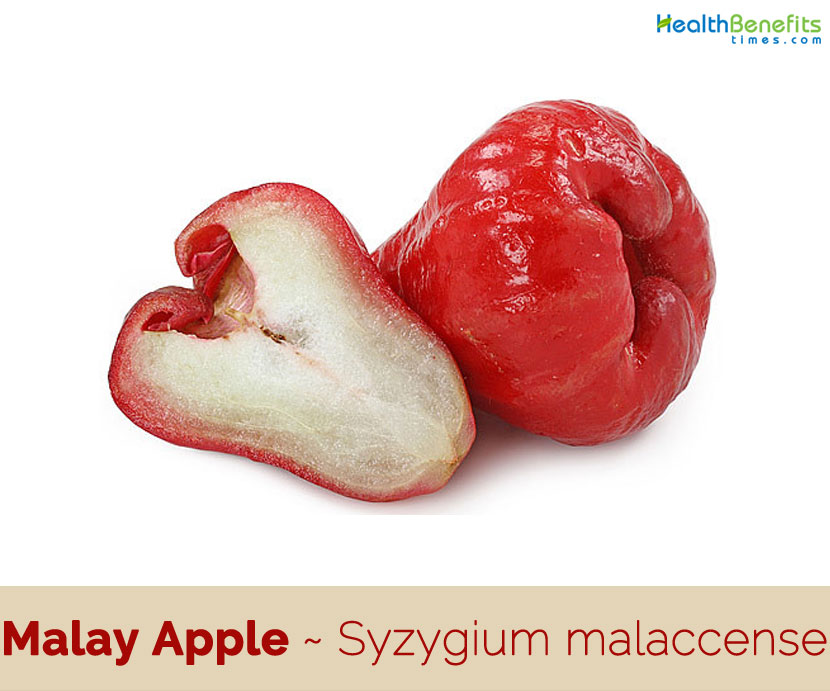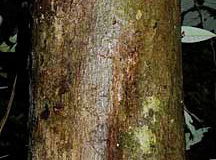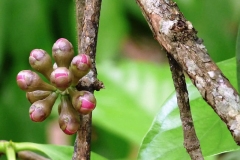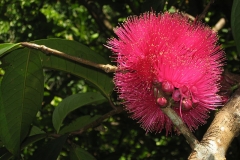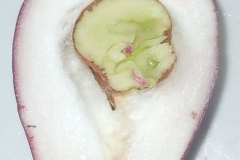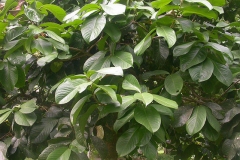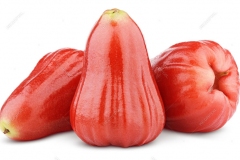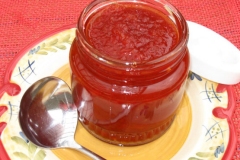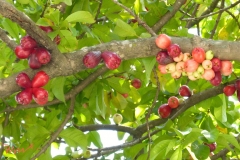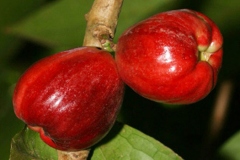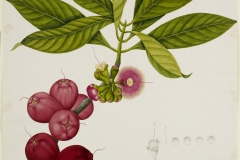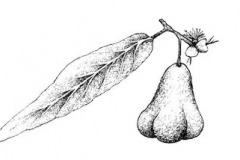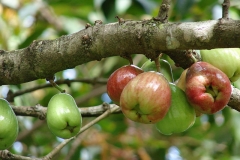Malay apple scientifically known as Syzygium malaccense is an evergreen tree belonging to Myrtle family Myrtaceae. The plant is native to Southeast Asia to Vanuatu, but its exact origin is uncertain, probably in the lowland rainforests of Peninsular Malaysia, Java and Sumatra. It is now cultivated and naturalized in many countries throughout the tropics, particularly in Indo-Malaysia, Southeast Asia, East Africa, Central and South America, Melanesia, Polynesia and Micronesia. It is one of the species cultivated since prehistoric times by the Austronesian peoples. They were carried and introduced deliberately to Remote Oceania as canoe plants. In modern times, it has been introduced throughout the tropics, including many Caribbean countries and territories.
Plant description
Malay Apple is a medium-size evergreen tree with a spreading but cone-shaped crown that grows about 5 – 20 meters tall, though specimens to 30 meters have been recorded from New Guinea. The straight, cylindrical bole can be 20 – 45 cm in diameter (to 130 cm in New Guinea), often branching from near the ground though sometimes free of branches for 10 – 15 meters, with buttresses at the base. Bark is pale-brown, rough, flaky or fissured. The plant is adaptable to a wide range of soil type from sand to heavy clays but prefers well drained, medium textured soils like loams, sandy clay loams, sandy clays, clay loams. It grows well in volcanic soils but is intolerant of alkaline or saline soils.
Leaves
Leaf blades are slightly curved upward on both sides of midrib; the lateral veins are slightly sunken and connected near margins. The upper surface of the leaf is dark green or green and usually slightly shiny, and the lower surface dull light green. Scattered minute gland dots are visible with a lens when the blade is held toward the light.
Flowers
Several to many odorless flowers are borne in clusters 4-5 inches across; almost stalk less on a short branched green lateral axis (cyme or panicle). Flower has a funnel-shaped, light purplish- green base (hypanthium) ¾ inch long and 7/16 inch wide at top, enclosing the ovary and extending as a broad tube 3/16 inch beyond. There are 4 broad, rounded, thickened, persistent sepals 1/8-3/16 inch long; 4 spreading, rounded, concave, purplish-red petals ½ inch long; the mass of stamens 1-11/4 inches long, purplish red with yellow dot antheis; and pistil composed of inferior 2-celled ovary and persistent purplish-red straight style about 1¼ inches long. As the stamens fall, the ground under the tree becomes a purplish-red carpet.
Fruits
Fertile flowers are followed by a large, fleshy, ovoid, pear-shaped, dumb-bell shaped or oblong berry 4–7.5 cm long, glossy, waxy, crowned by the incurved non-fleshy calyx segments. Color of the fruit varies from white, greenish white, dark pink, red, purple- red or white with red streaks. Flesh is 0.5-2.5 cm thick, juicy, white and fragrant. Normally Malay apple is red with pink or white streaks; the flesh is thick, rather dry and scented, but often bland. Eighty percent or more of the fruit is edible. Each fruit usually contains a single large, brown, sub globose seed that is 2.5-3.5 cm in diameter. Malay apple ripen about 60 days after bloom.
The flesh makes a jam prepared by stewing with brown sugar and ginger. Trunk of the Mountain Apple tree was used by the people of old Hawai’i to build beams for their hale, house and for fashioning bowls and poi-boards. A reddish brown dye for making patterns on tapa bark cloth, was processed from the bark and the root.
Health benefits of Malay Apple
Listed below are some of the popular health benefits of Malay Apple
1. Treat Eyes Health
In case you have problems with the eyes, maybe your body need vitamin A. Vitamin A on Malay apple fruit is high enough and helps to make your eyes health much better. With a healthy eye, your eyesight can be more clear and sharp.
2. Relieves fever
Malay apple can also be used as medicine to relieve fever. You can make the steeping of this fruit with warm water and give it to people with fever. Fever will gradually heal and fall.
3. Nourish the skin
The benefit of cashew boll for the skin is quite a lot. In addition to nourish your skin, this fruit can also help to make your skin smooth and rubbery. The content of vitamin C and other minerals will prevent you from diseases, such as skin cancer.
4. Prevents diabetes
Malay apple fruit helps to prevent diabetes. This fruit serves as a substitute for regular sugar that you often consume. The content of sugar in the fruit tends to be low but still can meet the needs sugar of your body. Therefore your blood sugar levels can be more controlled easily.
5. Increase Endurance
Maybe sometimes you feel your endurance is going down. No need to worry about it. Malay apple consists of 22 milligrams of vitamin C per 100 grams, this going to make your immune system stronger and fill the need of vitamin C in your body. Vitamins presents in Malay apple helps to get rid of various diseases that will attack your body health.
6. Treat Sprue
If you are often get sprue, maybe your body lack vitamin C. Because one of factor you get sprue is you lack of vitamin C. 100 gram of malay apple consists of 22 milligrams of vitamin C, this gonna better for you to treat your sprue. This fruit has some vitamin content that can treat sprue and protect your oral cavity from infection.
7. Overcome dysentery
Malay apple fruit has the property to overcome dysentery. This disease is a contagious disease; it needs to be addressed as soon as possible so as not to spread rapidly.
8. Strengthens bones
The iron in this fruit, help your bones become stronger. Including this fruits is quite beneficial and you do not have to worry about osteoporosis or another bone related problems.
9. Skin Health
An adequate amount of Vitamin A and C could be obtained from the Rose Apple which helps to prevent damage from the oxidative stress caused by the poor diet, stress, and pollution. It also reduces the dryness of the skin and reduces the wrinkles.
10. Prevent Acne
Acne vulgaris is a skin condition which leads to the inflammation caused due to skin infection. The research shows that the leaves of Rose Apple possess anti-acne properties such as anti-inflammatory, antioxidant and antibacterial properties. The experiment also shows that the presence of synergic actions results from the antioxidant, antibacterial and anti-inflammatory activities. Thus, S. Jambos assist in anti-acne activities. This study helps to know about the herbal medicines whereas various clinical trials are being continued.
11. Cure Liver Damage
Liver damage leads to various liver diseases which are caused due to the excessive consumption of alcohol, anemia, malnutrition, infection and hepatotoxic drugs. The research which was carried out at Gujarat Ayurved University shows that the leaves extract of Rose Apple consists of the liver protective agent. It leads to the effectiveness in the change in the function of the liver than the disease control group. The efficacy was worthy of comparison to the standard drug.
12. Prevent Constipation
Dietary fiber in Rose Apple supports the digestive system in the material movement and stimulate stool which is helpful for those having the irregular stools or constipation. It supports healthy weight and reduces the chances of heart disease and diabetes.
https://www.youtube.com/watch?v=A9-gsoN9a4I
Other Malay Apple Benefits
Here is the list of other benefits of Malay apple:
As Sprue Medicine
To treat a sprue, use the trunk of Malay apple tree. Trunk of Malay apple can be used as a sprue medicine, by just boiling the stem and drinking water.
Increase Baby’s Appetite
If your baby’s appetite is weak, maybe you can try this. Boil some water with young bark of Malay and put it in the glass. And then add some sugar to gives some taste and drink it to the baby. It can increase baby’s appetite.
Help Treat Wound on Tongue
If your tongue is wound, you can try this to treat it. Pick up the dry leaves of Malay apple and make it become powder. And apply it on the wound tongue.
Herbal Medicine for Itching
By using the root of Malay apple, itching can be treated. So don’t worry. But not only itching can treated by the root, but also swelling, relieving dysentery, shed the menstruation and diuretics.
Medicine for Fever
To cooling down the fever, not only by drinking the boiled water from fruits of Malay apple, but also from the leaves and it seeds too.
As Skin Moisturizer
To moisturize the skin, you can make it traditionally from the part of Malay apple’s tree. Just using the leaves. Make juice from leaves of Malay apple and put it on the skin to moisturize it.
Treat Common Disease
To treat common disease, you can treat it by processing the part of Malay apple such as fruit, leaves, or others.
As Antibiotics
Seeds bark, and leave of Malay apple show antibiotic activity and have an effect on blood pressure and breathing.
Treat Oral Infection
To treat oral infection in Samoa, some people use the leaves of Malay apple with the way make it to juice.
Treat Digestive Tract Disorder
To treat digestive disorder, you can use part of Malay apple tree. With the extract of bark from Malay apple tree, you can treat it. Extract of bark from Malay apple tree can treat throat infections and abdominal pain too.
Other Benefits for Pregnant Women
Here is the list of health benefits of Malay apple for pregnant women:
- Controlling blood pressure in pregnant women.
- Maintain the electrolyzed balance that exists in the body of a pregnant woman.
- Relieve muscle contractions to reduce the feeling of abdominal cramps and overcome nausea.
- Accelerate the development of red blood cells, which is needed during pregnancy.
- Accelerate the absorption of iron needed by the body during pregnancy.
- Strengthen the embryo
- Vitamins and minerals in Malay apple fruit are good natural antioxidants for pregnant women. Antioxidants are useful to prevent the growth of bacteria and germs that often attack pregnant women.
Traditional uses and benefits of Malay apple
- In Brazil, Various parts of the plant are used as remedies for constipation, diabetes, coughs, pulmonary catarrh, headache, and other ailments in Brazil.
- Root, fruit, leaves, and seeds are used as a febrifuge for fever, and the root is regarded as diuretic in Cambodia.
- The astringent bark is used for making a mouthwash for thrush in Moluccas.
- Root-bark decoction is used for dysentery, amenorrhea and as abortifacient.
- Coconut oil in which fragments of the bark have been soaked is taken as a purgative in Marquesas.
- Root may enter into an application for itches and a preparation of the root is given to alleviate swelling.
- An infusion of the bark is used for coughs in Futuna and Niue.
- An extract of bark scrapings is commonly administered to treat throat infections and stomachache, and is an ingredient in various remedies for a complex of abdominal ailments known as kahi in Tonga.
- Bark was crushed and its juices taken for sore throat, juice extracted from the bark was mixed with salt and applied to cuts in Hawaii.
- Powder from the dried leaves is reportedly used on a cracked tongue in Malaysia.
- In Samoa, an infusion of the crushed leaves or scraped bark is very commonly taken as a potion, the leaves are chewed and the juice swallowed, or the leaf juice is dripped into the mouth of an infant to treat mouth infections.
- A solution of the crushed leaves, or to a lesser extent the grated bark, is widely used to treat thrush in Cook Islands.
- Dried leaves are made into a powder used in the treatment of dry tongues in Malaysia.
- Itching can be relieved with a product made from the roots, which are also known to be diuretic and effective against edema.
- Fever is treated in Cambodia with a decoction made from the leaves, seeds or fruit, while crushing the leaves allows the extraction of a juice that can be applied on the skin as a cosmetic product.
- Plant is also used in Brazil, against various diseases such as coughs, pulmonary catarrh, headache, constipation or diabetes.
- They have been used for a long time to start menstruation and to relieve itching and cure dysentery.
- For sore throat, the inner bark is scraped or the whole bark is decocted.
- Juice of salted pounded bark used for wounds in Hawaii.
- Decoction of bark is used for thrush in Molucca.
- Decoction of fruit leaves and seeds used for fever I Cambodia.
- In Malaysian Borneo, decoction of stem and bark are used for diarrhea.
Culinary Uses
- The ripe fruits are eaten fresh, out of hand, in fruit salad, fruit cocktail, stewed with spices as dessert or eaten dipped in sauces.
- Pomerac fruit can also be processed into candied fruit slices.
- Half ripe fruits are used for pickles, jelly, and preserves.
- Ripe fruit is sliced and eaten as petjel (vegetable eaten with sambal sauce) and the young pinkish leaves are eaten raw as lalab (salad) with rice in Indonesia.
- In Indonesia, the flowers are eaten in salads or are preserved in syrup.
- The flowers are also eaten in Thailand.
- Young leaves and shoots are consumed as vegetables.
- Young leaves and flowers also eaten in Papua New Guinea.
- The flesh can be prepared as a jam, combined with raw sugar and ginger.
- It is also possible to make either red or white wine from the fruits, both types being very popular in Puerto Rico.
Other facts
- Tough, reddish timber is used for construction as house posts, fence posts, rafters, railway sleepers and for carving bowls.
- In Chuuk (Micronesia), it has been used to make outrigger booms.
- It is occasionally used for fuel-wood.
- Both blossoms and fruit were used to make leis in Hawaii.
Prevention and Control
Due to the variable regulations around (de)registration of pesticides, your national list of registered pesticides or relevant authority should be consulted to determine which products are legally allowed for use in your country when considering chemical control. Pesticides should always be used in a lawful manner, consistent with the product’s label.
Physical/Mechanical Control
Physical control methods such as cutting down or frilling (removal of bark completely around the base of the tree trunk) have been used in combination with herbicide applications in vigorous efforts to control some Syzygium species that have proved invasive threats to native flora in places such as Hawaii, the Galapagos Islands, and Pitcairn Islands. Physical removal of trees and replacing them with native species has also been a reported method for an invasive Syzygium species (S. jambos) in Costa Rica (Avalos et al., 2006).
Chemical Control
Syzygium species can be controlled by herbicides, and in places where species have become serious threats to native flora, a combination of physical and chemical control methods have been reported. Syzygium cumini, for example, forms a dense cover and because of its extensive cultivation as a fruit tree, has become very invasive in Hawaii, the Cook Islands, and French Polynesia; vigorous efforts are being undertaken in Hawaii to remove the species through chemical control. Syzygium jambos is likewise an invasive species on several Pacific islands, and has been reportedly controlled by applying herbicides.
References:
https://www.itis.gov/servlet/SingleRpt/SingleRpt?search_topic=TSN&search_value=505421#null
http://www.hear.org/pier/species/syzygium_malaccense.htm
https://npgsweb.ars-grin.gov/gringlobal/taxonomydetail.aspx?id=70774
https://www.cabi.org/isc/datasheet/52448
https://plants.usda.gov/core/profile?symbol=SYMA2
https://en.wikipedia.org/wiki/Syzygium_malaccense
https://www.growables.org/information/TropicalFruit/MalayApple.htm
https://hort.purdue.edu/newcrop/morton/malay_apple.html
http://www.tn-grin.nat.tn/gringlobal/taxonomydetail.aspx?id=70774
https://www.wikidata.org/wiki/Q31936
https://gd.eppo.int/taxon/SYZMA
http://www.theplantlist.org/tpl1.1/record/kew-199883
http://www.flowersofindia.net/catalog/slides/Malay%20Apple.html
http://tropical.theferns.info/viewtropical.php?id=Syzygium+malaccense
Comments
| Malay Apple Quick Facts | |
|---|---|
| Name: | Malay Apple |
| Scientific Name: | Syzygium malaccense |
| Origin | Southeast Asia to Vanuatu |
| Colors | White, greenish white, dark pink, red, purple- red or white with red streaks |
| Shapes | Large, fleshy, ovoid, pear-shaped, dumb-bell shaped or oblong berry 4–7.5 cm long, glossy, waxy |
| Flesh colors | White, spongy, juicy and mildly sweet to bland |
| Taste | Crisp, watery, earthy, and slightly sweet taste |
| Health benefits | Treat Eyes Health, Relieves fever, Nourish the skin, Prevents diabetes, Increase Endurance, Treat Sprue, Overcome dysentery, Strengthens bones, Skin Health, Prevent Acne, Cure Liver Damage, Prevent Constipation |
| Name | Malay Apple |
|---|---|
| Scientific Name | Syzygium malaccense |
| Native | Southeast Asia to Vanuatu, but its exact origin is uncertain, probably in the lowland rainforests of Peninsular Malaysia, Java and Sumatra |
| Common Names | Kavika Tree, Large Fruited Rose Apple, Malay Apple, Mountain Apple, Malacca Apple, Malay Apple, Malay Rose Apple, Mountain Apple, Otaheite Cashew, Otaheite Apple, Pomerac, Malaysian apple, Pink satin-ash, Rose-apple, Water apple, long fruited rose-apple, wax jambu, Malacca pear |
| Name in Other Languages | Assamese: Pani-jamuk Banaban : Te Kabika Bengali: Malaka jamrul, Mālaẏī jāmarula (মালয়ী জামরুল) Bolivia: Manzana del Brasil Brazil: Jambolao-de-Malaca Burmese : Thabyo-Thabyay, Thabyo Thabyang Cambodia: Chompuh kraham Caroline Islands: Apel, apel em Pohnpei, apel en Pohnpei, arfath, faliap, faliyap, harafath, paniap Chamorro : Macupa, Makupa Chinese : Hong Hua Pu Tao, Ma Lai Pu Tao, Ma Liu Jia Pu Tao, Yang Pu Tao Chuukese : Fááriyap, faaniyaap, faaniyap, faanyaap, faniap, faniob, faniyap, feniap, feniyap Colombia : Cereza Cuadrada, Pomalaca, Pomarosa De Malaca Cook Islands : Ka‘Ika, Ka‘Ika Makatea, Ka‘Ika Maori, Ka‘Ika Maori, Ka‘Ika Papa‘Ā, Ka‘Ika Tavake, Ka‘Ika Tavake, Ka‘Ika Tavake, Ka‘Ika ‘Enua, Kaika Makatea Costa Rica : Mazana De Agua Cuba : Ohia, Jamboissier Rouge, Malakel-Apfel, Manzana De Agua, Malayapfel, Mountain Apple, Pomme Malac, Pomarossa De Malaca, pera de Malaca Dominican Republic : Cajualito, cajuil de sulimán, cajuilito de sulimán, manzana de agua Dutch : Djamboe Bol El Salvador : Marañon Japonés English: Malay-apple, Malaysian apple, Otaheite-apple, Mountain-apple, Pink satin-ash, Pomerac, Rose-apple, Malacca apple, Malay rose apple, Otaheite cashew , Water apple, long fruited rose-apple, wax jambu, Malacca pear Fijian : Kavika, Kavika Ndamu, Kavika Ndamundamu, Kavika Vulvula, Yasi Kavika, kavikavula French : Jamalac, Jambosier Rouge, Poire De Malaque, Pomme De Malaisie, Pomme De Tahiti, Pomme D’eau, Pomme Malac, Jambose De Malaque, Poirier De Malaque, Pommier-Rose, Pomme malac French Polynesia: Ahi’a, ‘ahia-‘ura, ‘ahia-tea, ahia, ahia Tahit, keika French Polynesia/Marquesas: Kehi‘a, kehika, kehika inana German : Groszer Rosenapfel, Malabarischer Rosenapfel, Zahmer Jambusenbaum, Malaka- Apfelbauw, Malakka-Apfel, Malaysia-Apfel, Malacca-Apfel, Malakka-Apfel Guam : Makupa, macupa Haiti: Pomme de Jamaïque Hawaii : Ohi‘A ‘Ai Ai, ‘Ohi‘A ‘Ōhi‘ Kea, ‘Ōhi‘ Leo, ‘Ōhi‘ ‘Ula, ‘Ōhi‘ ‘Ai Ke‘Oke‘O Hungarian: Malájalma India : Burka Jamun Indonesia : Jambi Nipoe, Jambu Merah, Lutu Kau, Njambu Bol, Maku, Jambah, Jambol, Jambu Bol, Jambu Bol, Jambu Boa, Jambu Djene, Kuo, Jambu Bolu, Jampo Bolu, Jampu Pelo, Mutiha, Aloe, Lutune, Nutune, Omtulo, Rutuno, Upo, Goda-Goda, Gogoa, Gorogo, Jambu Tersana, Dersana, Jambu Bol, Jambu Bol, Jambu Kalupa, Jambu Keling, Darsana, Jammbhu Darsana, Gora Besar, Jambu Berteh, Jambu Bol, Gowa Merah, Jambu Bo, Jambu Jambak, Jambu Gadang, Wua Sumonda, Maufa, Kembes Mea, Kembes Raindang, Kao, Kochuwa, Kombot Moura, Kumpasa Mahendang, Kupa, Kupa Maamu, Kupa Raindang, Mangkoa, Mangkoa Maamu, Kumkolo, Kopo Kaul, Rutuul, Bol, Jambu Bul, Gora Lamo, Gora Tome, Suo, Suo Kohori, Kau Noel Japanese : Maree Futo Momo Jamaica: Otaheite apple Javanese: Jambu bol Khmer : Chompuh Kraham Kosrae : Acpuhl Kwara‘ae: Afio, kabirai, sa‘au, u‘uinialakau Lesser Antilles: Pome d’maite, pomera, pomm damou, pomme d’amour, pomme de Tahiti Malay: Darsana, Jambu bar, Jambu bol, Jambu bubul, Jambu kapal, Jambu kling, Jambu melaka, Jambu merah, Jambu tersana Malayalam: Malayan āppiḷ (മലയൻ ആപ്പിൾ) Malaysia : Jambu Merah, Jambu Bol, Jambu Kling, Jambu Bubul, Jambu Kapal, Jambu Bar, Jambu Melaka, Jambu Susu Mangarevan : Ke‘Ika, ahia Maori (Cook Islands): ka‘ika, ka‘ika ‘enua, ka‘ika makatea, ka‘ika maori, ka‘ika papa‘ā, ka‘ika tavake, kaika makatea Marquesan: Kehi‘a, kehika Marshallese: Abōl Micronesia, Federated states of: Acpuhl, faaniyaap, faaniyap, faanyaap, fááriyap, faniap, faniob, faniyap, fasniyaap, feniap, feniyap Myanmar: Di-la, thabye-byu, thabyo-thabyay, thabyu-thabye, zabu-thabye-ahni Nicaragua: Pera de agua Niuean : Fekakai Northern Marquesas : Kehika Kehika, Kehika Inana Northern Mariana Islands: Macupa, makupa Palauan : Kidel Panama: Marafion de Curasao, marañon de Curacao, mianzana de Faiti Papua New Guinea : Laulau Philippines : Tual, Gubal, Mangkopa, Tual, Makopang-Kalabau, Tamo, Makopa, Yambu, Tersana Rose Apple Pohnpeian : Apel, Apel En Pohnpei, Paniap, Polish: Czapetka malajska Portuguese : Jambu, Jambu De Malacca, Jambo vermelho, Jambeiro, jambolão-de-malaca, jambolão-de-Malaca Puerto Rico: Manzana malaya, ohia Rotuman : Hahi’a Russian: Sitsigiui Malakskii, Malayskoye yabloko (Малайское яблоко), Malaiskoe iabloko, Sitsigium malakskij (Сицигиум малаккский), Sizigium malakkskij (Сизигиум малаккский), yamboza (ямбоза) Samoan : Nonu, nonu ‘ula, nonu fi‘afi‘a, nonu fiafia, nonu ui Sinhalese: Pini jambu (පිනි ජම්බු) Societies : ‘Ahi‘A Solomon Islands: Afio, kabirai, sa‘au, u‘uinialakau Southern Marquesas : Kehi‘A Spanish : Pomarosa, Manzana Malaya, Pomarrosa De Malaca, Yambo, Manzana de agua, Cajualito, Mazana de agua, Manzana de agua, Manzana malaya, Pera de agua (Venezuela), Pomagás, Pomalaca, Pomarosa de Malaca, Marañon japonés, Pomarrosa de Malaca, Yambo Sundanese: Jambu bool Swedish: Malajäpple Tagalog: Makopang kalabo, Makopang kalabaw, Tersana, Yanba, Yanbu Tahitian: Ahia Tahiti, ‘Ahia-Tea, ‘Ahia-‘Ura Tamil: Malāy nīrkkumaḷi (மலாய் நீர்க்குமளி) Thai: Chom-Phu-Daeng, Chompu-Mamieow, Chompu-Saraek, Chom phûu mamieo, Chmphū̀ ma h̄emī̀yw (ชมพู่มะเหมี่ยว) Tongan : Fekika Kai, fekika Tuvaluan: Apolo Solomona Ulithian : Harafath Uvea, Futuna: Kafi ka Vietnamese : Man Hurong Tau, Cay Dao, Dièu Dò, Cay Roi, Roi hoa đỏ Venezuela : Manzana De Agua, Manzana Malaya, Pera De Agua, Pomagás Wallisian: Kafika Woleaisan : Faliyapa Yapese : Arfatlh Arfatlh, Harafath Harafath, Faliap Faliap, Faliyap |
| Plant Growth Habit | Medium-size evergreen tree |
| Soil | Adaptable to a wide range of soil type from sand to heavy clays but prefers well drained, medium textured soils like loams, sandy clay loams, sandy clays, clay loams. It grows well in volcanic soils but is intolerant of alkaline or saline soils |
| Plant Size | 15–30 m high with straight trunk, 130 cm diameter and buttresses |
| Bark | Pale-brown, rough, flaky or fissured |
| Leaf | Opposite, petiolate (10 mm long), elliptic-oblong to broadly oblong-lanceolate, 15–30 cm by 7.5–15 cm, entire, acuminate apex, acute base, glabrous and dark green on both sides, venation pinnate, secondary veins closed, not prominent. The young leaves are pinkish |
| Flower | Showy, red, 2.5 cm across, bisexual; calyx turbinate, 1.2–1.8 cm long with 4 pale yellow, rounded lobes; corolla with 4, red or pink rounded petals, 7–11 mm long, early caducous; ovary inferior, with a simple style up to 2.5 cm long; stamens many (about 200), free, red, 1–2 cm long |
| Fruit Shape & Size | Large, fleshy, ovoid, pear-shaped, dumb-bell shaped or oblong berry 4–7.5 cm long, glossy, waxy |
| Fruit Color | White, greenish white, dark pink, red, purple- red or white with red streaks |
| Fruit Skin | Thin |
| Flesh | White, spongy, juicy and mildly sweet to bland |
| Seed | Each fruit usually contains a single large, brown, sub globose, 1.5–2 cm diameter seed |
| Propagation | By seeds |
| Taste | Crisp, watery, earthy, and slightly sweet taste. Some may have an astringent, slightly bitter aftertaste |
| Plant Parts Used | Fruits, bark, seeds, roots |
| Health Benefits |
|


